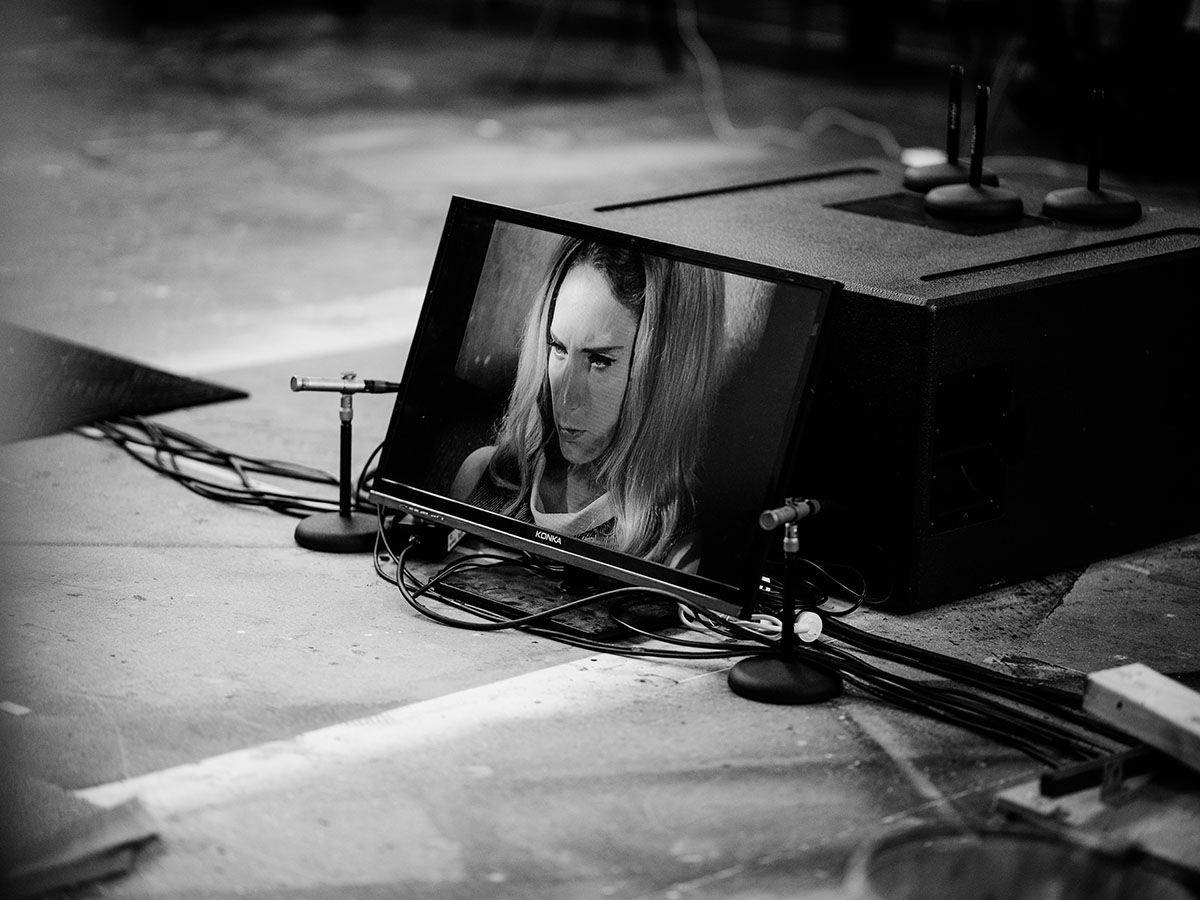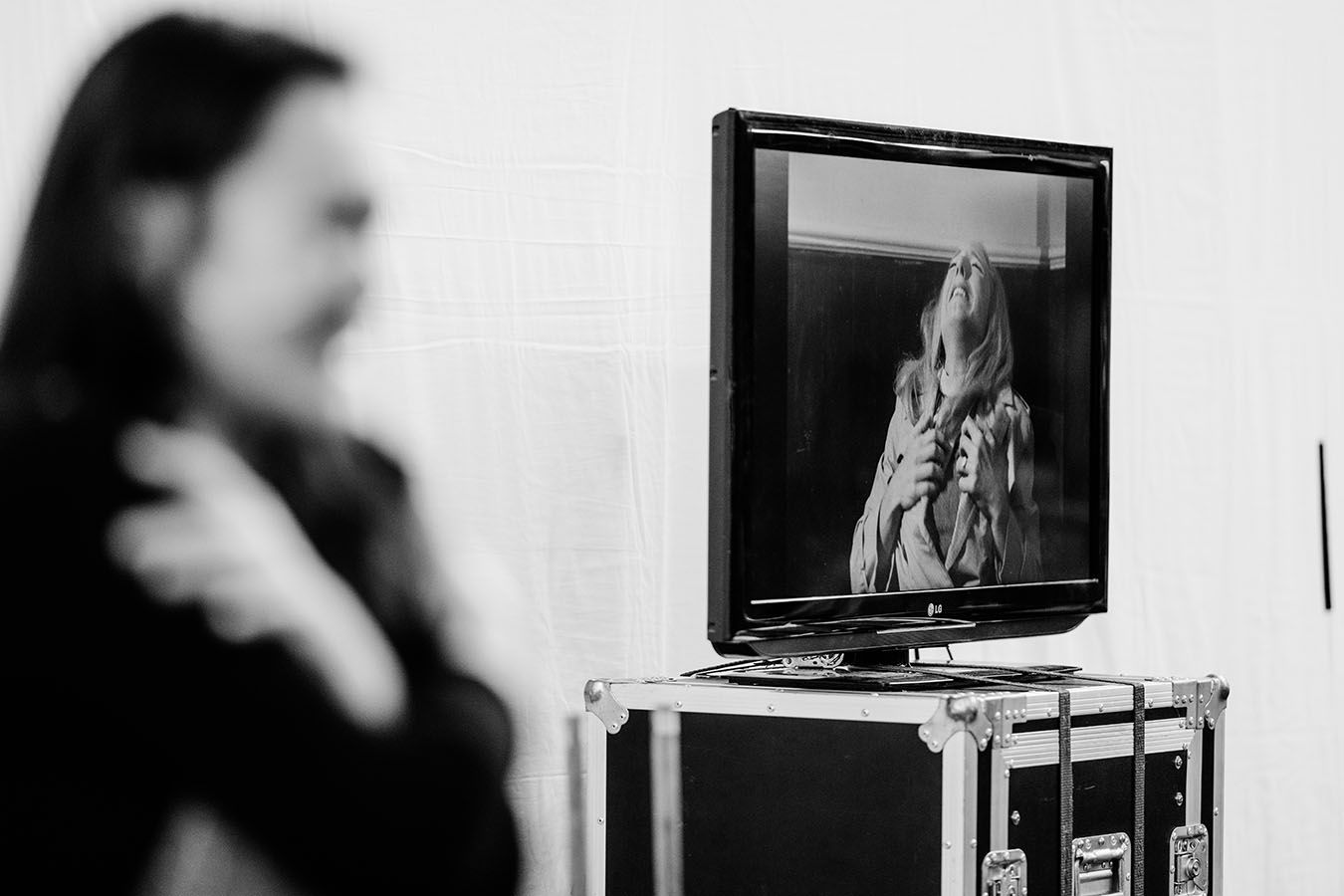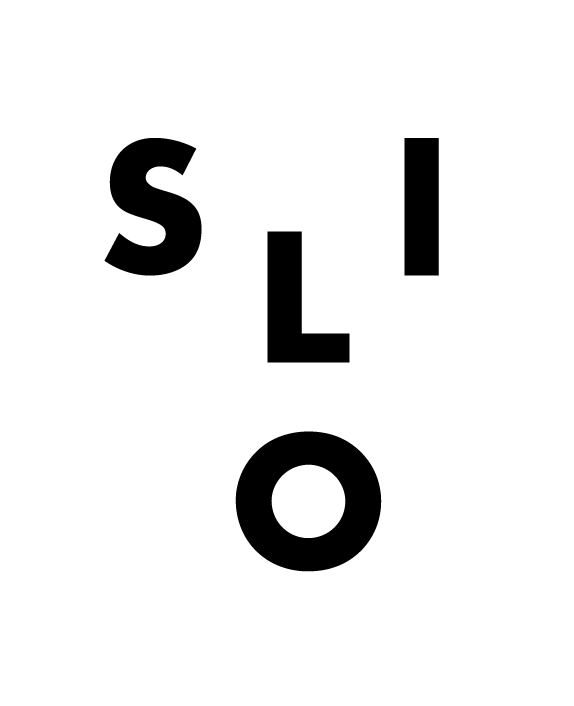It Keeps Coming Back from the Grave
Horror academic Erin Harrington and Leon Radojkovic, creator and composer of Silo Theatre’s work Night of the Living Dead, on the reanimation of this seminal work at a pertinent time in our socio-political context.
For the last decade, Live Live Cinema has been breathing new life into forgotten classics of independent and cult film. Their dynamic, breakneck productions marry projected film with music, Foley effects and dialogue, all performed live by actors who are stretched to their limits. This year's production, which runs 2 – 12 Nov, sees Silo Theatre reanimate seminal horror film Night of the Living Dead, one of the most influential independent films in the history of cinema. The film’s shocking exploration of social and political dread makes for provocative and pertinent viewing in a time of crisis.
Erin Harrington, an arts critic and academic whose work focuses on horror, and Leon Radojkovic, the show’s creator and composer, sit down to discuss the film, its legacy, and its extraordinary adaptability.
Sam Snedden, Sophie Roberts and Leon Radjokovic in production. Photo credit: David St George
Erin Harrington: George A Romero’s horror classic Night of the Living Dead (1968) is a gritty, disturbing film. It placed its rotting hands right onto the third rail of American social fears and anxieties, not least the domestic paranoia of the Cold War, the horrors of the Vietnam War, and the racist violence accompanying the Civil Rights Movement. It also has significant cultural clout; it set the rules for contemporary zombie cinema and marked a significant shift in the horror genre itself. More than 50 years on, much like its uncanny reanimated ghouls, it keeps coming back from the grave. What appeal does this seminal film have for you as a theatre maker in Aotearoa?
Leon Radojkovic: I love it on so many levels – that it's an independent film that's gone on to have such a lasting legacy, that it was shot on such a tiny budget within such a tight timeframe, and most of all that despite all the challenges facing the filmmakers, they created something that, on a purely aesthetic level, is incredibly effective. It’s shot with a kind of gritty realism, but also balances that with moments of genuinely haunting and ghoulish beauty. There is a real artistry to it.
The other main attraction of the film is that once you get past the zombies and gore, it's an extraordinarily potent piece of oppositional pop culture, and one that still resonates today. To run through the list, you mention the Vietnam War. We have recently witnessed scenes of America's withdrawal from Afghanistan recalling iconic images of Vietnam War reportage, such as the fall of Saigon, with similar political and economic dynamics at play. We are also still contending with a deadly yet witless virus that operates by infecting and, in the worst-case scenario, killing its host. We have also seen increasing attention paid to ongoing racial or ethnic injustices, and other forms of social hierarchies, which is one of the main threads of the movie. The film speaks incredibly strongly to our current circumstances.
EH: The beauty of the film is that the seeming ‘cause’ of the crisis – radiation on a NASA space probe that’s returned from Venus – is ultimately arbitrary. The point is that it’s a catalyst: a way of ripping back the curtain on a myriad of barely suppressed social and political ills.
"The point is that it’s a catalyst: a way of ripping back the curtain on a myriad of barely suppressed social and political ills."
LR: Exactly. I find the film’s general themes of the fear of the other, and that fear and mistrust thwarting the possibility of communication and co-operation in the face of an overwhelming external threat, to be particularly apropos, whether we are talking about our impotence in the face of the climate catastrophe we are brainlessly staggering on with, or indeed, I would argue, the economic system that is driving it.
EH: The allegorical power of the film is also enhanced as, yes, the ghouls or the zombies of the film are inherently ‘other’, but they’re a uniquely horrifying category of creature because they are also us. We’re the threat. Our friends and loved ones, ‘safe’ people, are made suddenly monstrous and have come back to haunt us.
LR: Absolutely. I’ve always liked the zombie as a monstrous figure, in that it is a grotesque, degraded reflection of ourselves and some of our basest drives – to consume, devour and reproduce. Romero has talked about the fact that, originally, he never thought of them as zombies, or even ‘ghouls’, but rather more simply as dead neighbours. I find that to be an unsettling, yet also weirdly poignant, thought.
EH: Yes – it’s so intimate! It embodies the fragility and collapse of so many of the distinctions we use to keep ourselves whole and sane: familiar/unfamiliar, living/dead, them/us, human/non-human, rational/irrational…
Rehearsal shots. Photo: David St George
LR: I suppose the main aspect of this sort of ambiguity, or potential for a sudden rupture, that interests me in the film is the fragility of the social order. Civilisation and civility are fragile, and it doesn’t take a lot for things to degenerate into chaos, irrationality, fear and violence.
EH: This also highlights how useful the zombie figure is as a way of expressing complicated and disturbing tensions that are otherwise hard to articulate. My favourite take on the zombie isn’t that zombies represent this or that, but that they are metaphor incarnate – literally made flesh. That must open up some pretty interesting possibilities for artists and creatives.
LR: That’s really interesting. Certainly, when comparing them to some other top-tier cinematic monsters, like vampires or werewolves, for example, zombies have proven to be much more malleable and versatile as a kind of floating signifier that artists can use to speak to a range of issues – Romero did that himself throughout his career.
"Zombies have proven to be much more malleable and versatile as a kind of floating signifier that artists can use to speak to a range of issues – Romero did that himself throughout his career."
EH: Yeah! It also helps that zombies are inherently cinematic. Early zombie films of the 1930s and 40s played fast and loose with Western accounts of Haitian Vodou and folk practice. Still, unlike most classic monsters, Romero’s ghoul doesn’t have a specific background in folklore or Gothic literature. The zombies just are.
LR: Exactly, they're much less lore-bound than other creatures. I think that’s also why Night of the Living Dead, despite being over 50 years old, still packs a real punch. Although it was certainly a snapshot of and comment on the times in which it was made, it still feels vital and rich in its applicability and relevance today.
EH: This rich history means that some audiences will come to the show with a real love for and familiarity with the material. Others will be brand new to it, even if they know the film by its reputation or influence. What challenges and opportunities are there in adapting such a seminal film, and in such an interdisciplinary way?
LR: With Live Live Cinema, we are always seeking to use the languages of theatre, composition and sound design to breathe new life into, or indeed ‘reanimate’, the original text of the film. Sound is an incredibly important and powerful aspect of filmmaking. It can go a long way towards shaping how the audience will interpret the images they are viewing, even though it generally goes largely unnoticed. In using these tools, within the context of a live theatrical performance, the goal is always to, in some way, recontextualise and, ideally, perhaps even improve on the original work.
EH: I love the notion of reanimating the text. One of the film’s idiosyncrasies is that it’s always been in the public domain because of a cock-up with the copyright notice. So it’s been revived, adapted, reimagined, rereleased, over and over again. The film itself is a zombie work!
Image by Jack Lawrence, source: Flickr
LR: That's really great. I wonder if the fact that it's been in the public domain since its release is part of the reason it was able to so thoroughly infect our pop-culture landscape. Creativity is about borrowing, stealing, repurposing and synthesising. I get the sense that we, as artists, have been convinced that copyright law in its current form protects us and works in our favour. However, as far as I can see, it seems to stifle artistic innovation, and primarily benefit large corporations. Sadly, I don’t have one of those.
EH: Yes – there’s an inherent hybridity in public-domain work in general, which strikes me as a key part of your kaupapa, too. Does this inform the decisions you make about what to reanimate, revive, remix?
LR: Absolutely. We work with low-budget films that are rough diamonds. They have genuine artistry and flashes of brilliance. Still, as a rule, they are also constrained by things like breakneck shooting schedules, clunky scripting or dialogue, awkward performances from day players and, often, very poor or, at best, serviceable soundtracks. Part of the Live Live Cinema ethos is to create new hybrid works that simultaneously honour and champion these pieces of forgotten silver.
Part of the Live Live Cinema ethos is to create new hybrid works that simultaneously honour and champion these pieces of forgotten silver.
EH: Adaptation across contexts also offers up new ways of talking about things. The zombie is an inherently absurd creature, so we can manipulate the interplay between humour and horror. There’s a fine line between laughter and screaming, right? Humour can be horrible, and often the abject itself is funny, be it something gross, or an existential reminder of our fallible, meat-sack bodies. My experience of your production of Roger Corman’s Little Shop of Horrors was that it was dangerously fast and absolutely hilarious – I was more worried for the live actors than for Seymour in the film! That film’s less inherently political, though, so how do you balance the very serious allegorical issues we’re discussing here with the potential for hilarity (comfortable or otherwise) in performance?
LR: I'm not a huge fan of comedy films, but I do love horror comedies. I feel that horror and comedy paradoxically co-exist together quite comfortably. They operate with a similar set of principles and logic that’s generally centred on surprise. I think horror and comedy films are the only genres that really live or die by their ability to surprise the audience, whether it’s a great punchline or a gruesome, unexpected moment of violence. Often the best horror is made all the more stark and disturbing by its juxtaposition with levity or humour. One seems to underline or highlight the other.
EH: Yes – in the simplest of terms, they both rely on a setup and a punchline, tension and release. But with horror–humour hybrids you also have the discomfort of not knowing which way it will go. That opens up considerable affective and expressive possibilities – political ones, too.
LR: I think this is a potent device that we are exploring with this production. The film itself has moments and themes that are provocative and disturbing, but there is also something inherently funny about performers on stage playing multiple characters and making sound effects. There's a lot of scope for that manipulation of tension and release, and the creation of moments of ambiguity and discomfort, which I find interesting.
EH: And this discomfort coheres, I think, in that meeting between film, performance, context and audience. You have the clash between late-1960s American and contemporary New Zealand cultural contexts. Characters played by two people attack one another and try to survive, while the actors are at war with the anarchic nature of the performance challenge. All the while, audiences relish in watching the actors being punished by the demands of the show. There’s a rupture in the way that sound and image and body all relate and cohere as the audience tries to make sense of it… all during a pandemic, in the midst of anthropogenic cataclysm! It’s as if the show – as well as society – is trying to eat itself.
LR: Yes, we basically set ourselves a monumental challenge, and then have to constantly find ways to avert disaster through creativity. If a film is a swan – graceful and beautiful above the water, and all the furious paddling down below – we show you the whole swan, with two skilled performers and the entire apparatus of filmmaking exploded across the stage.
However, the fact that the film still feels absolutely relevant to me today speaks, of course, to the power of the work, but, more disturbingly, it also speaks to a kind of cultural stalling or impasse. I think this is something felt particularly acutely by people of my generation – a sense of resignation, a sense that nothing can change, a sense of what cultural theorist Mark Fisher called the “foreclosure of the future”. I do believe society is eating itself, but the real existential threats, the real monsters, are the moribund political institutions and bloated vampiric corporations crouching like vast elder-gods in the outer darkness. We are the idiots arguing in the farmhouse about whether it’s best to hide in the basement or in the living room.
"I do believe society is eating itself, but the real existential threats, the real monsters, are the moribund political institutions and bloated vampiric corporations crouching like vast elder-gods in the outer darkness."
EH: Although there’s a kernel of hope in the absurd, right? You keep trying in the face of the incomprehensible. Think Estragon and Vladimir in the final moments of Waiting for Godot: "I can't go on like this.” “That’s what you think.
LR: I think that’s actually part of the fun. In the show there is a sense of giddiness, of teetering on the brink of chaos. A sense of danger is reflected in the demands placed upon our two performers. It’s about virtuosity and elegance in the face of the impossible.
This piece is presented as part of a partnership with Silo Theatre and appears in the show programme. Silo covers the costs of paying our writers and team while we retain all editorial control.
Header image: David St George
Live Live Cinema: Night of the Living Dead
2 – 12 November
Hollywood Avondale
Tāmaki Makaurau
Book your tickets here!






